Apple iPhone 4S: Thoroughly Reviewed
by Anand Lal Shimpi & Brian Klug on October 31, 2011 7:45 PM EST- Posted in
- Smartphones
- Apple
- Mobile
- iPhone
- iPhone 4S
The A5 Architecture & CPU Performance
The original iPhone debuted with a single 412MHz ARM11 core built on a 90nm process. The 3G improved network performance in 2008 but left the SoC untouched. It wasn't until the iPhone 3GS in 2009 that the SoC got a major performance and power update. Apple moved to a 65nm process node, a brand new ARM Cortex A8 based SoC and an upgraded GPU. The A4 released in 2010 once again gave us a process shrink but kept the architecture unchanged.
Apple's A5, first introduced with the iPad 2, keeps process technology the same while introducing a brand new CPU and GPU. The A5 integrates two ARM Cortex A9 cores onto a single die. The improvement over the A4 is tremendous. At the single core level, Apple shortened the integer pipeline without reducing clock speed. With a shorter pipeline the A5 gets more done per clock, and without decreasing clock speed the A5 inherently achieves better performance at the same clock. The move to the Cortex A9 also enables out-of-order instruction execution, further improving architectural efficiency. I've heard there's a 20% increase in performance per clock vs. the Cortex A8, but combine that with the fact that you get two A9s vs a single A8 in last year's design and you get a pretty big performance increase.
There are several situations where the A5's two cores deliver a tangible performance benefit over the A4's single core. Like Android, iOS appears to be pretty well threaded. Individual apps and tasks can take advantage of the second core without a recompile or version update. The most obvious example is web browsing.
Mobile Safari is well threaded. Javascript rendering can be parallelized as well as parts of the HTML parsing/rendering process. All of the major Javascript performance benchmarks show a 60 - 70% increase in performance over the A4, which is partially due to the availability of the second core:
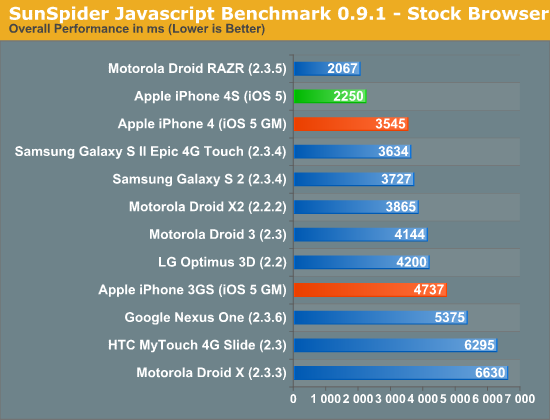
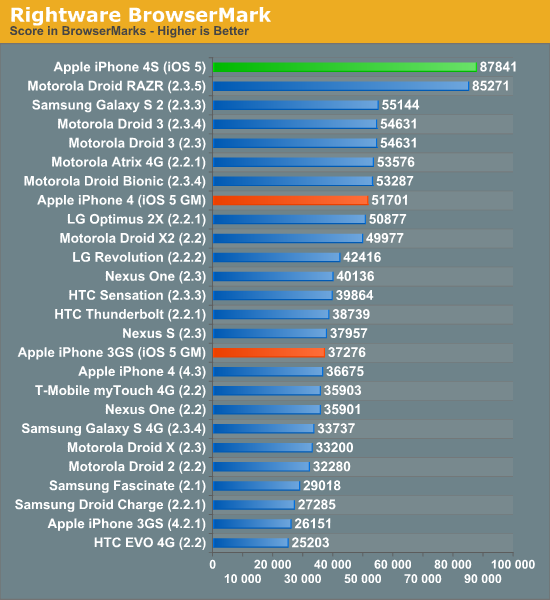
This translates directly into faster page load times. As you can see in the video below, the iPhone 4S (left) loads the AnandTech front page over WiFi in about 5 seconds compared to 9 seconds on the iPhone 4 (right). That's really the best case scenario, the improvement in the next page load time was only about a second (7s vs 8s).
Typical improvements in load time fall in the 10 - 70% range, contributing significantly to the phone feeling snappier than its predecessor. To quantify the improvement I ran through our standard web page loading suite, a test that hits AnandTech, CNN, NYTimes, Engadget, Amazon, Digg and Reddit hosted locally on our lab's network. The average page load time over WiFi for all of the pages is below:
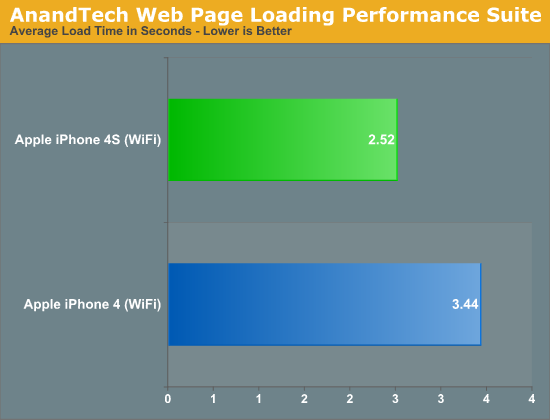
While web page rendering is a natural fit for multiple cores, I was surprised by how poorly threaded some apps ended up being. For example, although I did see performance improvements in exporting edited videos from the iOS version of iMovie, the gains weren't always evident. A quick profile of the app revealed that much of the export process is still single threaded. Just as we've seen on the desktop, there will be some added work necessary to get all apps to utilize multiple cores on iOS.
It's not always performance within an app that saw improvement with the A5: application install and launch times are also much quicker on the 4S. The time to launch Epic's iOS Citadel demo went from 32 seconds on the iPhone 4 to 22 seconds on the 4S. While the iPhone 4 may feel fast enough for many users, the 4S is noticeably faster.
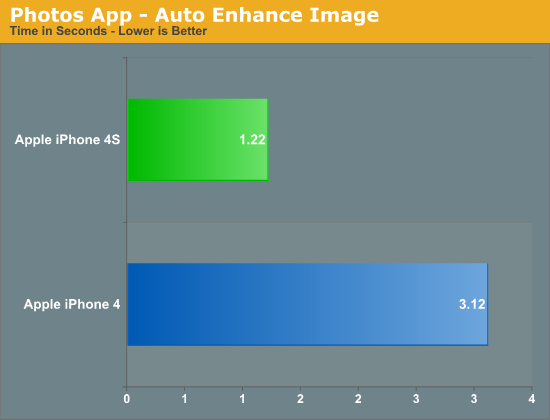
Much of the faster feel comes from by shaving off of seconds here or there. For example, I noticed apps like Messages pop up just slightly quicker on the 4S and you'll see your listing of messages a hair faster than you would on the 4. In the video above you get a brief idea of the sort of subtle improvements I'm talking about. YouTube launches a fraction of a second quicker on the 4S vs the 4.
These subtle decreases in response time are simply icing on the cake. The move from a 4 to a 4S is one of those upgrades that you'll notice right off the bat but will really appreciate if you go back to an iPhone 4 and try to use it. If you do a lot of web browsing on your phone, you'll appreciate the 4S.
I wasn't entirely sure whether or not I could attribute all of these performance improvements to the faster CPU. It's possible that some of the tests I mentioned are IO bound and Apple could have used faster NAND in the 4S. To find out I rounded up a bunch of iPhone 4Ses at all available capacities and measured sequential write speed:
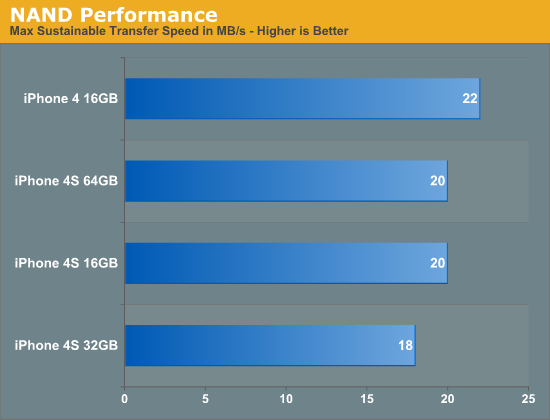
Apple uses multiple sources for NAND so it's possible that you'll see these numbers move around a bit depending on your particular phone. It looks like the iPhone 4S' NAND is no faster than what Apple shipped last year - at least in sequential write speed. The target appears to be 20MB/s and Apple does its best to stay around there. My iPhone 4 is actually pretty quick at 22MB/s but the advantage isn't significant enough to make a huge deal about. I don't have a good way of measuring random IO performance yet but application launch time is largely governed by sequential IO so I don't expect we're seeing gains from anything outside of the CPU and memory bandwidth in the earlier tests.


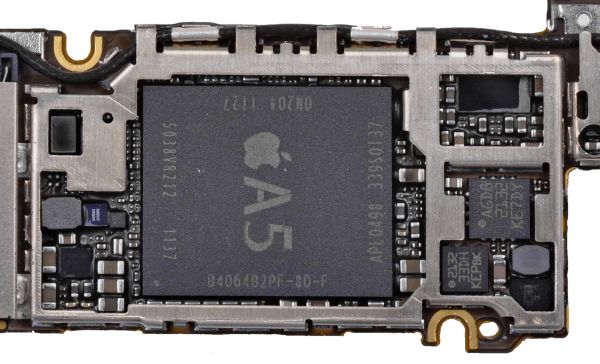








199 Comments
View All Comments
a5cent - Wednesday, November 2, 2011 - link
Nobody will use it to support Windows Phone. Ryan was certainly talking about Windows 8 and tablets. WP8/Apollo will run on Qualcomm's S4 SoC and on nothing else. An OS that can make assumptions about the hardware it is running on can include performance optimizations that would be impossible to do otherwise, and is also much easier to test. Apple and Microsoft seemingly agree that this is the better approach.Penti - Wednesday, November 2, 2011 - link
Actually they will of course, see Brians latest pipeline post http://www.anandtech.com/show/5038/stericsson-anno...Windows Phone 7-series devices need DirectX/3D and SM3.0 support, it has been discussed before and it's precisely this that prompts them to release products on 544. ST-E will produce SoCs for Windows Phone in cooperation with Microsoft and in partnership with Nokia which they have supplied before and has an extensive partnership and relationship with. At least they would hardly care for Windows 8 when choosing parts. They will hardly support DX9 and SM3 on Mali-400. They wouldn't bother if it was just for Windows for ARM any way. Even though Ryan referred to Windows 8 it doesn't make my post any less relevant and justified.
dagamer34 - Monday, October 31, 2011 - link
My best guess is that other SoC vendors would have had a hard time selling a SoC with that big a GPU until Apple did it. They don't want to loose the "speeds and feeds" game. We'll probably see more chips with larger dies in the future to compete with what Apple comes out with.Anand Lal Shimpi - Tuesday, November 1, 2011 - link
This is extremely accurate. The best thing Apple could have done for competition was ship an iPad with a 122mm^2 SoC inside.Take care,
Anand
Penti - Tuesday, November 1, 2011 - link
Not to mention every other application for ARM SoCs in this multimedia heavy world. It's more the tablet itself that drove this as well as other media player applications and all the other applications that aren't as power constrained as mobile phones. That was set out for for some time.mashimaroo - Monday, October 31, 2011 - link
i gave my spare case to my gf thinking it would fit right on until i noticed the vibrate lock switch was moved. My friends thought it was a defect but i knew there was no way. Unfortunately i had to buy another case after already shelling out $700. =( still im happy. The mirror ability is great and i can watch all my shows straight off my iphone to my aaxa p4 pico projector. All i had to get was the vga cord from the apple store for another $30.pretty much plug and play after though. ANGRY birds 80 INCHES instead of 3.5 inches. I'll admit its pretty fun to watch the giant birds fly across my walls.
kishorshack - Monday, October 31, 2011 - link
Really loved this reviewkudos to anandtech team
medi01 - Tuesday, November 1, 2011 - link
1) Ridiculous BS sentences about "improved vibration" that obviously come straight out of Apple's marketing mouth2) No real comparison vs competitors (guess what, AMOLED screens wipe the floor with iphones, no wonder)
No real comparison, but thorough kissing all over apple's butt. Formidable review, indeed....
doobydoo - Tuesday, November 1, 2011 - link
If there weren't charts showing the faster CPU/GPU combination as compared to all the other Android competition.If there wasn't a thorough analysis of the screen, showing that the iPhone 4S trades blows (winning and losing) vs the best Android can offer 9eg EMOLED).
If there wasn't a thorough analysis of wifi speed, battery life, as compared to other Android phones...
You would have a formidable comment, indeed....
rd_nest - Tuesday, November 1, 2011 - link
Where did it show faster CPU?